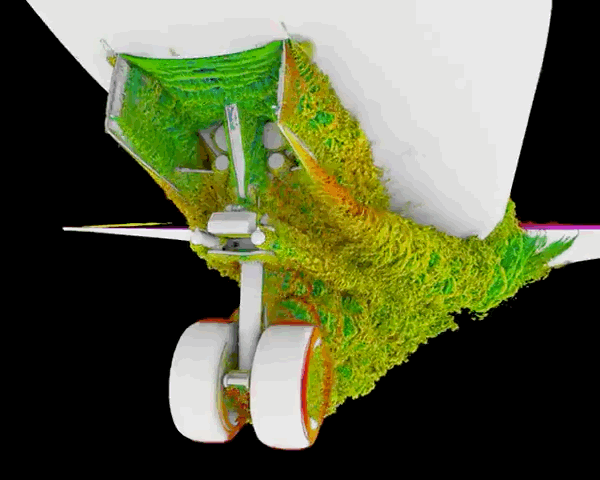Noah here. Back in the summer, I wrote two editions of WITI about Formula 1. Most of the focus was on the lack of competitiveness in the sport, which seems to be a function of three cascading causes: 1) Money buys 2) aerodynamics which in turn causes 3) turbulence. Essentially the richest teams spend the most money developing their cars, which mostly comes down to tiny aerodynamic adjustments that help their drivers cut through the air with as little drag as possible. Those winglets and modifications also have the knock-on effect of causing additional turbulence, which most in the sport refer to as "dirty air" that makes it harder for other drivers to follow closely and pass. Things have gotten bad enough that the focus of the sport’s technical rules overhaul in 2021 is almost entirely on allowing cars to follow more closely by eliminating turbulence.
Turbulence bubbled up for me again recently in this excerpt from James Bridle's book New Dark Age. In it, he describes the rising levels of turbulence we are experiencing both in the air and on the ground, in the form of cultural unpredictability. “An advisory circular on preventing turbulence-related injuries,” explains Bridle, “states that the frequency of turbulence accidents has increased steadily for more than a decade, from 0.3 accidents per million departures in 1989, to 1.7 in 2003. These figures are already severely out of date.”
Why is this interesting?
Turbulence, as Quanta deputy editor Michael Moyer points out, is a hard physics problem:
On the physical side, turbulence happens when a smooth fluid flow starts to split into smaller eddies and vortices. These swirls then break into smaller swirls, with those swirls begetting ever-smaller whorls, an unpredictable cascade that dissipates the energy from the original smooth stream. These whorls all affect one another, making it impossible to precisely predict what is going to happen to any particular particle in the fluid you’re measuring. On the large scale, energy dissipates gradually and with a semblance of order. On the small scale, chaos abounds.
This kind of complexity makes modeling the phenomenon a computationally intensive exercise. At the center of all that math is an equation called Navier-Stokes, which I did my best to try to wrap my head around by reading/watching some YouTube videos, but it turns out to be one of the hardest problems in mathematics. That’s not my take: The Clay Institute included the equation amongst its seven Millenium Problems, for which it offers $1 million to anyone who can figure them out (or, in the case of Navier-Stokes, to “make substantial progress”). “Although these equations were written down in the 19th Century,” the Clay Institute site explains, “our understanding of them remains minimal.”
Even with that minimal understanding we still manage to model some fantastically beautiful/maddening visuals. Take the example below from NASA, for instance, which is “the simulated flow field around the nose landing gear of a Boeing 777.”

Turbulence is a side effect. It’s the thing that happens as a fluid (of which air is one) interacts with anything else. While it may be possible to predict the second-, third-, or fifteenth-order effects of reasonably simple interactions, as you start to layer in more real-world variables your ability to predict outcomes can quickly shift to impossible. This, in essence, is the idea behind the butterfly effect, chaos, and complexity theory: Even a reasonably simple set of starting variables can create interactions that are beyond our ability to understand. Small scale events can cascade into much larger ones.
Beyond that, though, you have this particularly interesting thing that is happening in Formula 1 and I suspect in many other parts of society as well. Because all this aerodynamic modeling is computationally intense. It’s also massively expensive (more computers cost more money). In racing, this meant the teams with the most money could find more and more ways to reduce drag in their cars. This led to a kind of arms war of winglets, as teams attempted to find more and more ways to direct air around their car, thereby reducing drag.

But the second-order effect was an increase in turbulence for everyone else as these little bits and bobs made for unpredictability in the air as other cars pass. In other words, when this shift started to happen, it only furthered the split between the haves and have-nots in the sport, because those with more money could pay for better aerodynamic understanding and, at the same time, make those cars around them less competitive by chucking out dirty air. Eventually, in 2014 the sport’s governing body put a cap on the amount of computational aerodynamic modeling a team could do.
But that didn’t seem to help either. It’s hard to know exactly why, but it seems the damage had been done and the teams with an advantage in aerodynamic understanding just stayed in the lead. On top of that, with all the cars creating turbulence, it made even the most expensive computer models far less effective because they’re all based on the cars running through smooth air (known as laminar flow). So now you have this third-order effect that the very models that created the problem are far less useful in the face of the current environment.

In all this is a compelling story for the role of turbulence, I think. The F1 story of causation—money buys better aerodynamics which drives ever-growing car complexity that creates more turbulent air, reducing competitive racing and the predictiveness of aerodynamic computing clusters—is a physical analog to aspects of what appears to be happening in culture. While that particular chain of events may be specific to sport, some arrangement of the elements can be seen in the major political events of the decade, the dominance of superheroes in entertainment, and even in the flash crashes of finance.
On top of that, it also presents an interesting theory for the expanding split in inequality, because the car is not subject to the turbulent air of competitors is the one running in front, cutting through the laminar flow of open road. To that end it should be no surprise that Mercedes has won six double titles (F1 awards a constructor and driver champion) in a row, making it the most dominant run of championships in the history of the sport. (NRB)
Heartwarming Reddit Post of the Day:

Quick Links:
Surviving in frigid weather for 20 days (CJN)
The FT goes deep on the mavericks behind the Ghosn escape (CJN)
Demand for ginseng creates a “Wild West” in Appalachia h/t BP (CJN)
Thanks for reading,
Noah (NRB) & Colin (CJN)
Why is this interesting? is a daily email from Noah Brier & Colin Nagy (and friends!) about interesting things. If you’ve enjoyed this edition, please consider forwarding it to a friend. If you’re reading it for the first time, consider subscribing (it’s free!).


